A General Introduction
We all know H2O is water. Water also consists of several minerals such as calcium, magnesium, zinc, iron, sodium, bicarbonate and potassium.
Amongst these minerals the concentration of calcium and magnesium determine the hardness of water. GH stands for General Hardness.
It’s a measure of the amount of dissolved calcium and magnesium in your aquarium water.
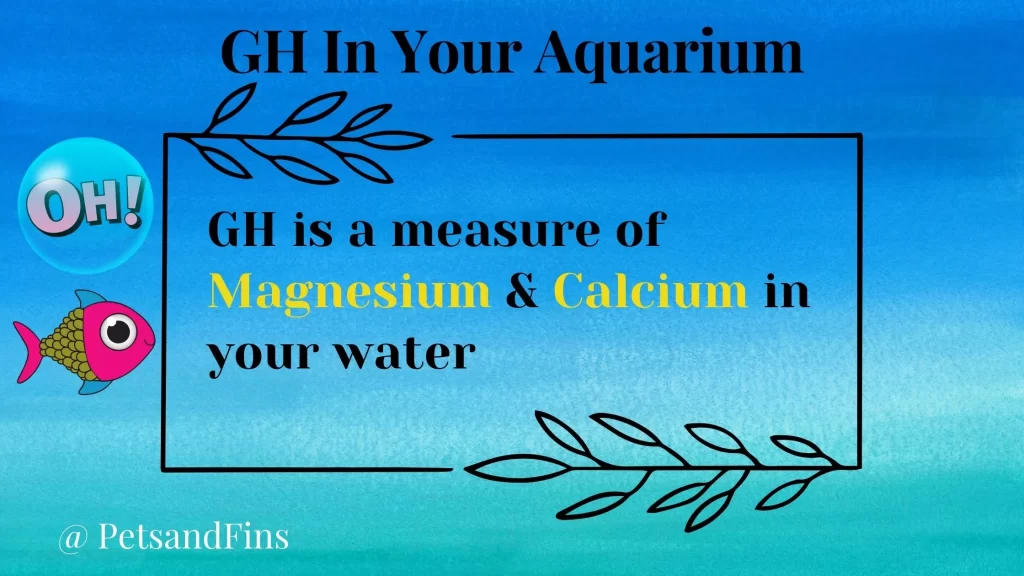
The GH Scale
GH is measured on a scale from 1 (softest) to 30 (hardest), with 7 being ideal for freshwater fish. Some might wonder if GH and pH are the same. Although pH and GH have a bearing on each other, they are not the same.

Why Does GH Vary?
There are many reasons for GH levels to vary, such as having soft water or hard water in your area, using tap instead of distilled water to fill up your tank, adding salt into the tank, or even just leaving lights on too long.
By measuring and monitoring your GH regularly you can ensure that it stays where it needs to be for optimal health benefits to both plants and fish!
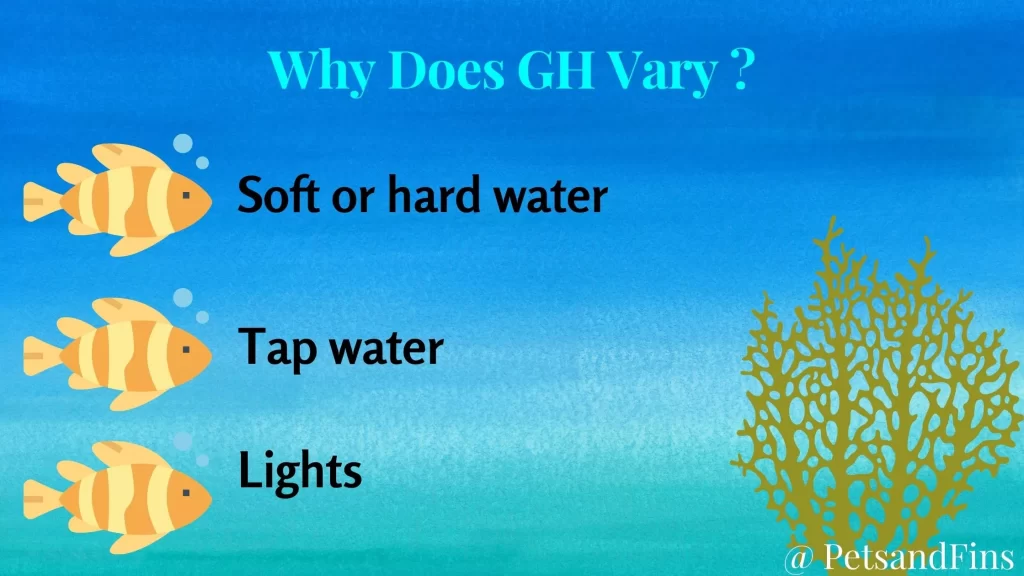
What Are Ranges Of GH?
The range of GH levels varies slightly depending on who you ask, but the general consensus is pretty similar. It also depends on the type of fish you want to have. GH is generally expressed in degrees (dGH). Sometimes as parts per million (PPM).
Freshwater fish tanks and ponds should ideally stay within 4-12 dGH. In case of shrimps 4-8. Cichlid and brackish water fish need 12-20 dGH.
If your tank has freshwater plants and Discus fish, a lower dGH between 3- 8 or 200 PPM is recommended. Axolotl’s need 7-14 dGH.
If you have live plants in your aquarium maintaining 4-8 would be good.
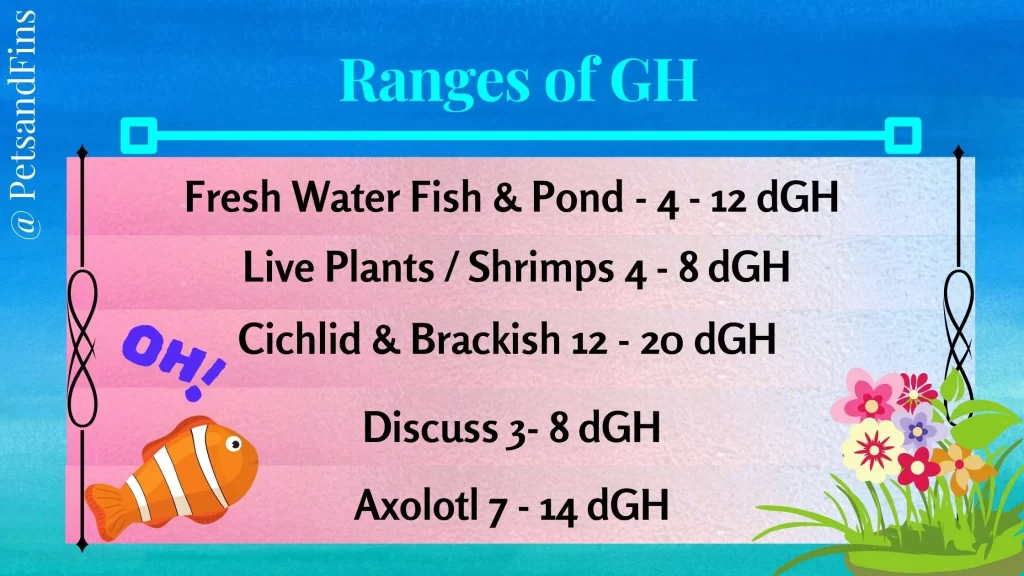
The conversion chart from degrees to ppm is below. This chart also tells you how soft or hard the water is.
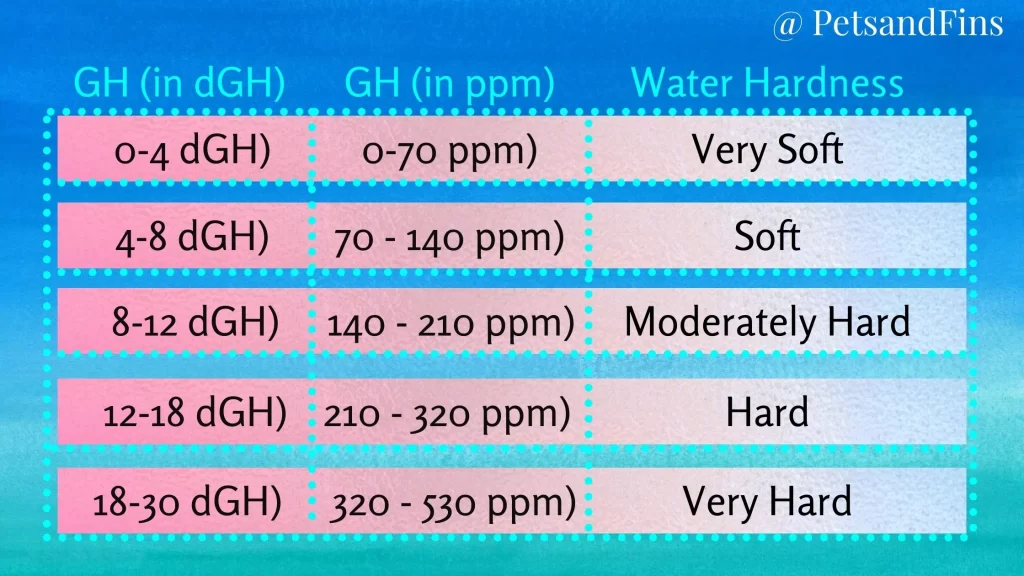
Minor GH fluctuations around either side of this isn’t necessarily a big issue as long as they’re not constantly changing and providing an unhealthy environment for the fish.
Anything lower can lead to issues with maturation of live plants and anything above this can result in health issues for fish.
At the same time though having GH levels higher than 20° can also cause similar problems simply due high mineral content leading into excessive slime coating forming on surfaces (including inside gills) making them more susceptible to infections from parasites and even issues with breathing.
As already mentioned, depending on your setup you may need to alter your GH levels slightly or not alter it at all.
Too low a GH will make it difficult/impossible for freshwater fish who require hard water conditions to survive – resulting in stress, disease & ill health. It is therefore important that you do not mix different types of fish.
How Does GH Affect Fish?
GH affects fish in a variety of ways, including how well they can form their protective coating.
If there isn’t enough calcium and magnesium present in the water then it will be difficult for them to produce this slimy layer that helps protect against disease and infection as well as helping with osmoregulation (the regulation of salt concentrations within the body).
It also affects the neurology of the fish and they can end up spiralling in the tank.GH is important because Fish need the minerals present in water. In other words, Fish need the electrolytes. So, here is what exactly happens.
Fish excrete minerals through their urine. To compensate the minerals lost, the use the minerals from the water. This is called osmoregulation. So, it is more important that your water has these electrolytes. Lack of GH can cause holes in the head of the fish.
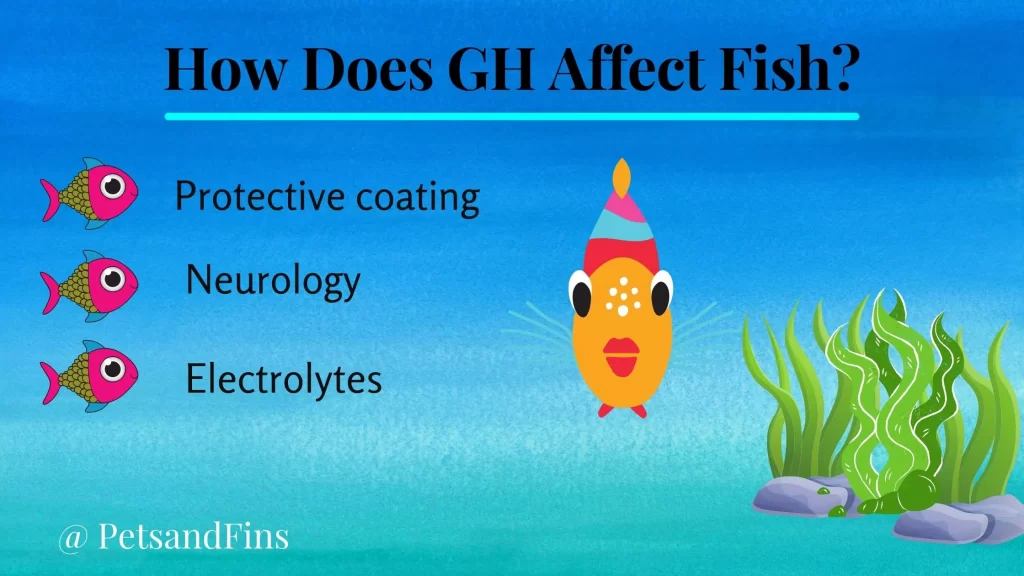
Does GH Affect pH?
GH also has an important role to play when it comes to stabilization of your aquarium’s pH level. However, this is indirect because GH only affects the KH and in turn the pH. So, do not worry too much about GH in relation to pH.
*If you want to know All About Aquarium Water pH, Causes And Ways To Maintain, click here.

How Does GH Affect KH?
GH and kH are often expressed together as they work closely together. This is because the levels of these two minerals need each other for stability!
When there isn’t enough GH then your aquariums water will become unstable causing fluctuations in both ph and kh (kH). This means a KH depletion increases the dependency on GH or an increase in CO2 resulting in the pH getting affected. The following charts below will help you understand better.
However, when you have high levels of both compounds them things becomes harder.
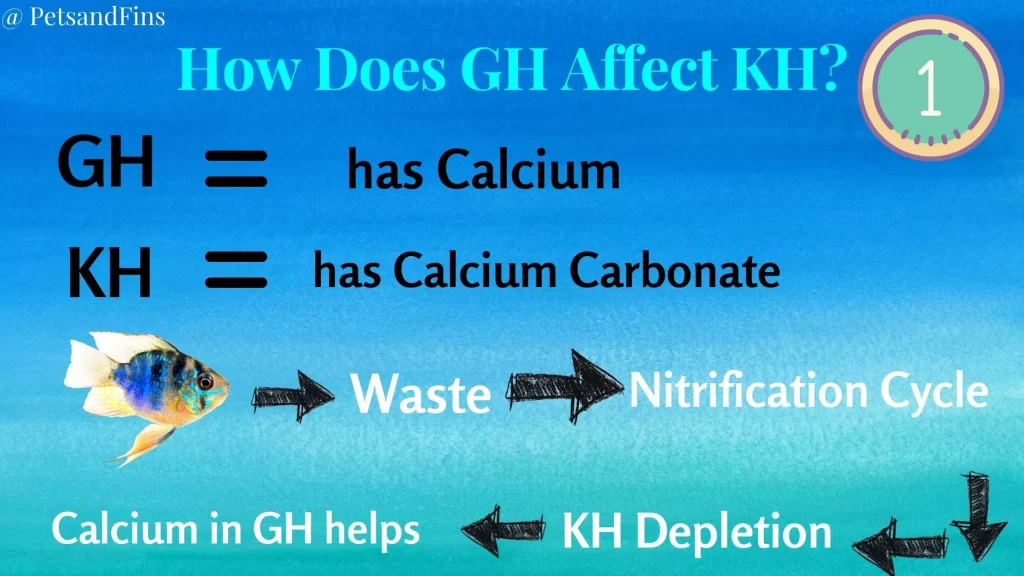
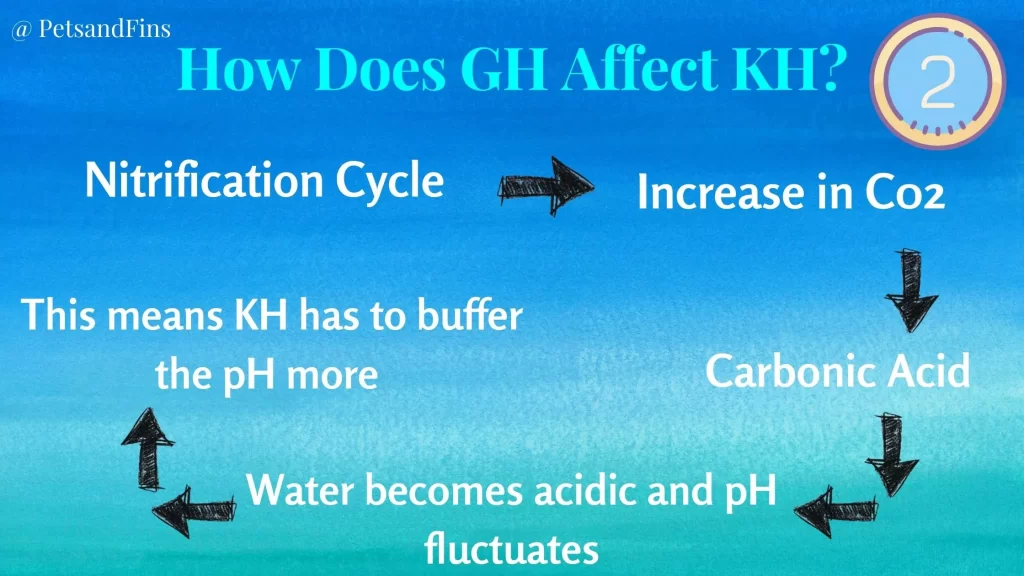
What Happens If You Have High GH?
High levels of GH can lead to lots of issues with kH and thereby your pH. Your aquarium’s water will become unstable, leading to fluctuations in both pH and kH.
Actually, low GH is more a problem than high GH. In any event, high GH also has its effects and cannot be totally ignored. It is only in comparison that lower GH is a greater issue.
Fish can have problems breathing. New fish may not be able to adjust to the environment and may die. If the phosphates are high the algae growth may increase.
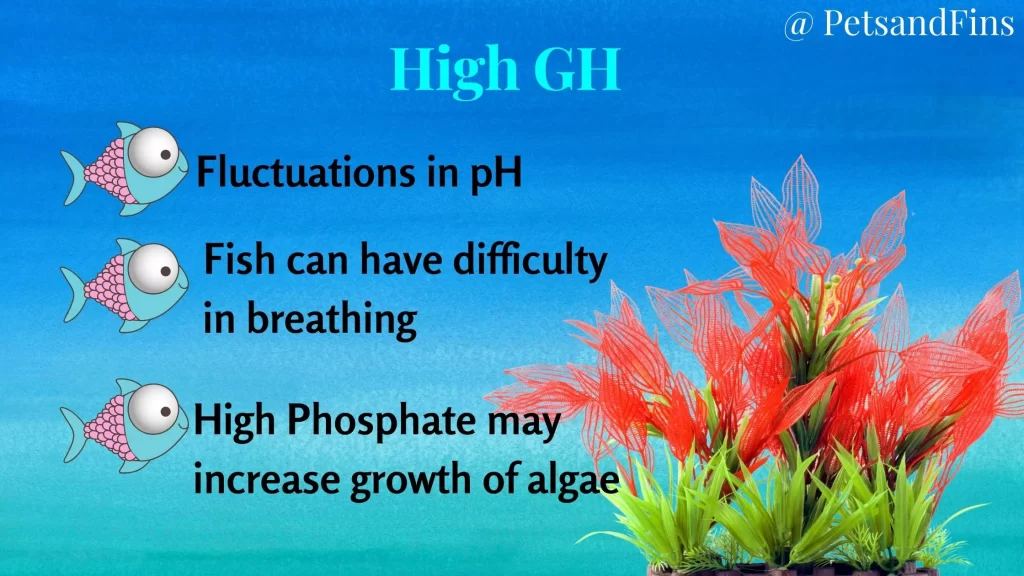
What Happens If You Have Low GH?
Low GH affects the growth of fish and even the live plants in your aquarium. The fish will not be able to get the required electrolytes thus causing eventual death.
With low GH it may also be hard for fish to form their protective slime coating, making them more susceptible infections & diseases caused by poor osmoregulation (the regulation of salt concentrations within the body).
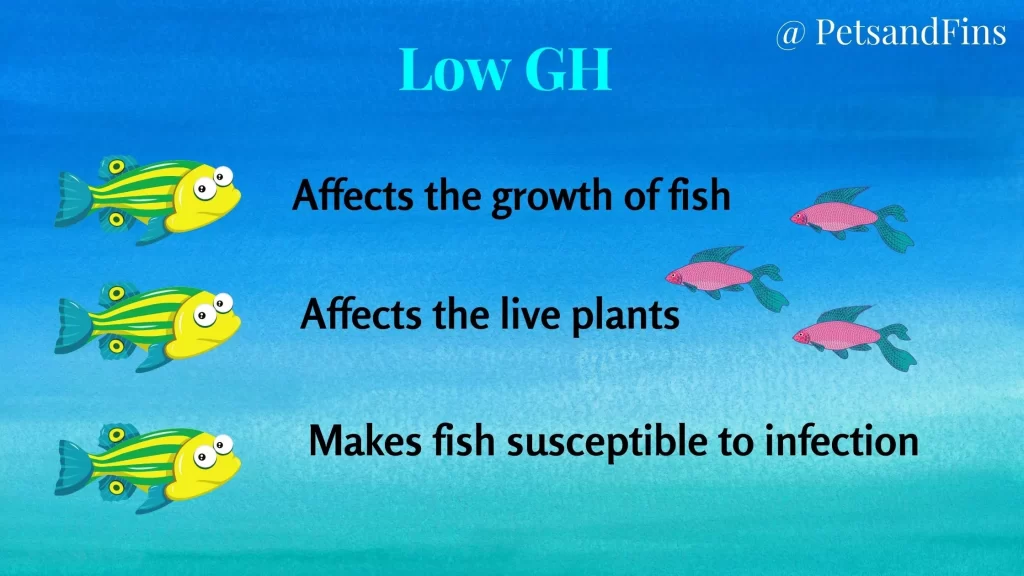
When Should You Measure GH?
The best time to do this is when your aquariums lights first turn on at the start of each day so that there isn’t any natural sunlight present which could interfere with results (as well as ensuring conditions are stable).
You will need to test for both GH & kH, but if only one needs adjusting then you can focus solely on just making adjustments accordingly rather than having to test for other issues!
A great idea is also to check your aquariums GH before and after a water change as this should give you a better indication of any fluctuations.
However, it’s important that these are carried out under the same conditions as mentioned above – ensuring things aren’t being influenced by lighting or natural sunlight.
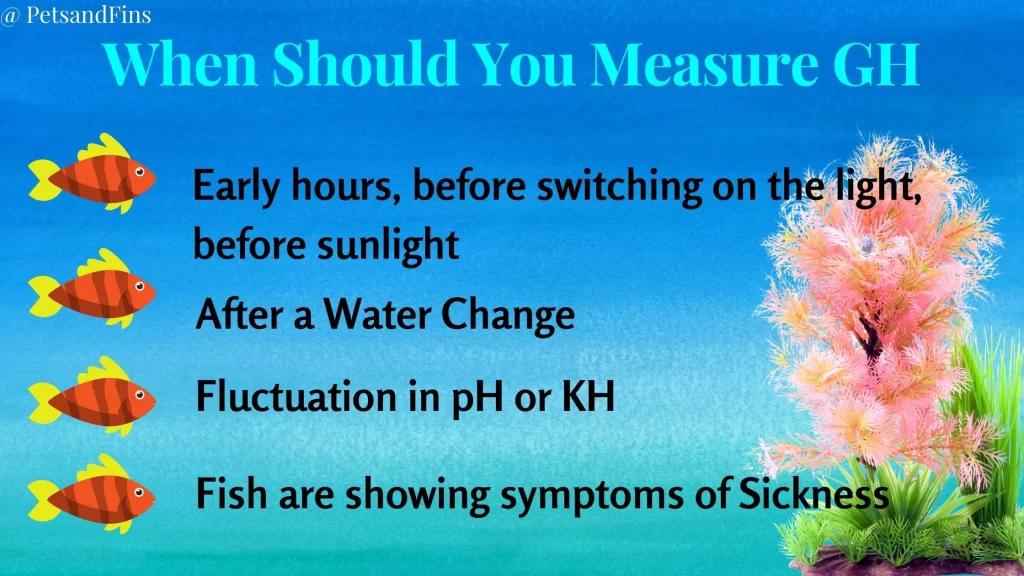
How Do You Measure GH?
GH testing kits are available which help you test the GH. You also get testing strips which are easy to use. Electronic testers are also available. They are called tool pens. You can look at buying comprehensive testing kits which may be cheaper than individual testing kits.
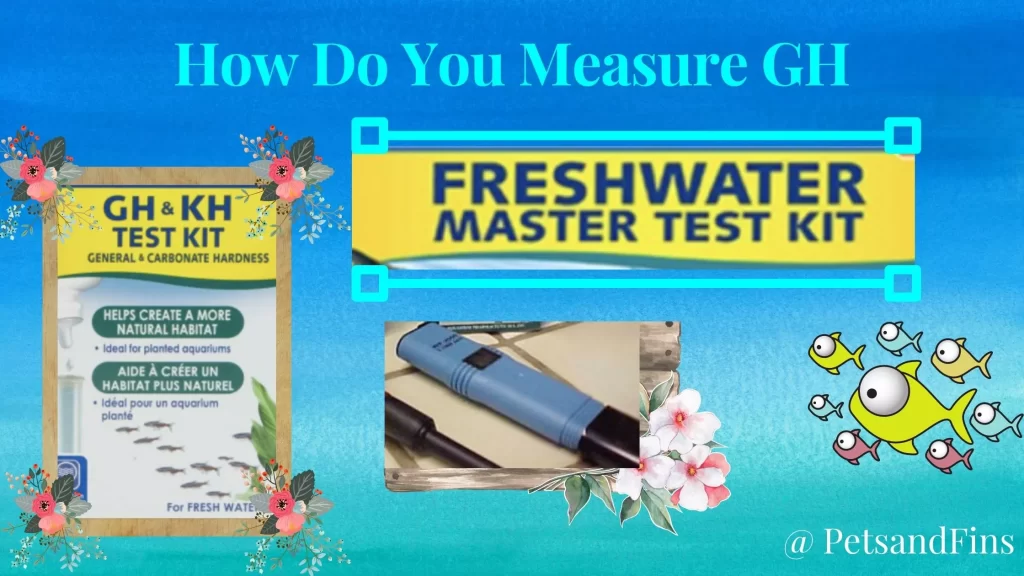
What GH is Best For Freshwater Fish?
Generally, fish require GH between 4°dGH and 12°dGH. For most community aquariums aim to keep GH around 8-12°. This is because there shouldn’t really be any issues with ph & kh and these ranges allow them to remain stable even during water changes.

What GH is Best For Live Plants Fish Tank?
Live plants require a GH of around 4°dGH to 8°dGH.This will allow the use of CO₂ fertilizers without any issues during growth periods.
As mentioned before, it’s important that you make sure your equipment matches these ideal ranges for live plants fish tanks.
As well as this, it would be best not to over stock your aquarium with too many fish until both GH and other parameters have stabilized at their respective levels.

How To Increase GH?
To increase GH levels, you can use additives. However, it’s important not to overdo this as once again we don’t want KH & pH fluctuations – especially when live plants and community fish require stable conditions for their well-being.
You could also use an additive instead of mixing with your own waters providing you know what exactly is missing. In either case make sure everything you have researched thoroughly before actually altering your aquarium’s system.
Pro Tip 1: Mineral Blocks are available which ensure the presence of electrolytes in the water which is good for fish and thereby also maintaining the GH.
Pro Tip 2: Do not use additives with calcium sulphate or chloride. Use ones with Calcium carbonate and Calcium Gluconate.
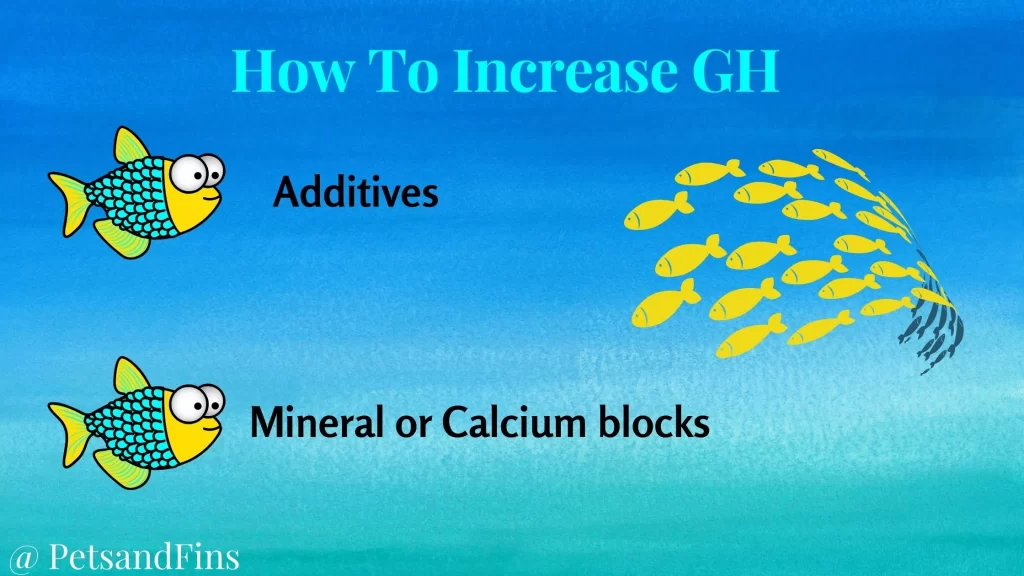
How To Lower GH?
To reduce GH levels, you can simply add RO (reverse osmosis) or DI (Deionized) filtered tap water which is devoid of minerals already. Adding peat moss is another option but I would not advise using it as the sole option. It is best if you combine RO/DI water and have peat moss to handle the GH.
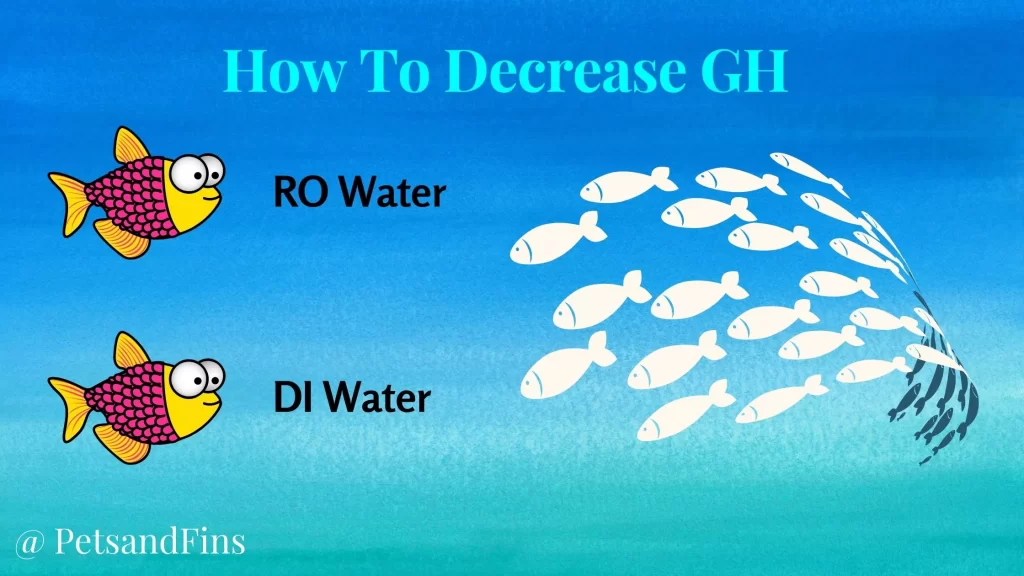
How To Keep GH Levels Stable?
The best way would be to monitor GH levels at least once a week, but this is also dependant on your aquarium’s size. If you have a smaller aquarium the water volume will change faster.
However, if you have larger aquariums, then checking these factors will depend on the situation. Ideally, I would recommend once a week unless you see fish dying and there is a problem in the aquarium. Once you stabilize, you won’t
If your fish are fine without any issues or fluctuations then there shouldn’t really be an issue. But again, this depends entirely on individual setup since each tank may use different items.
As always – it’s important to remember that you should not ever alter GH, KH or pH when your fish are healthy & happy in their conditions! Making changes without knowing how these will affect them can have very severe consequences for both they and the rest of your aquarium.
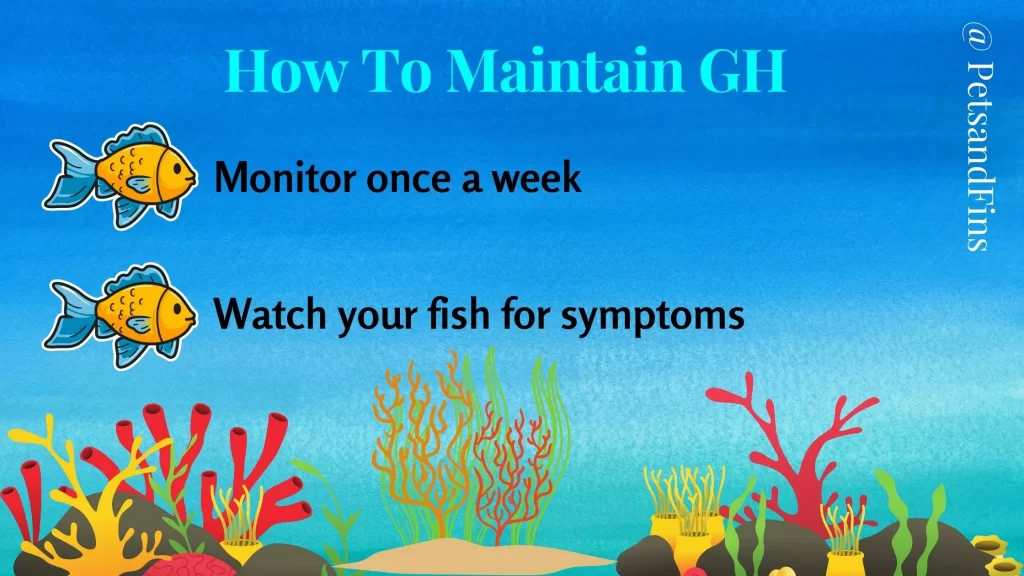
What If my GH is normal But My Fish Are Not Doing Well?
It can be the case that your GH is stable in terms of ppm, and you are still facing problems. This may happen when there is an imbalance between the magnesium and calcium ions in your aquarium water.
It may be the case that either there are more magnesium ions with very less calcium ions or vice versa. In such a situation, testing your magnesium and calcium would be a wise thing to do.
Depending on your results, you can supplement the lower ion with additives. Calcium blocks etc. are available which you can use. Do use branded products which are trusted.
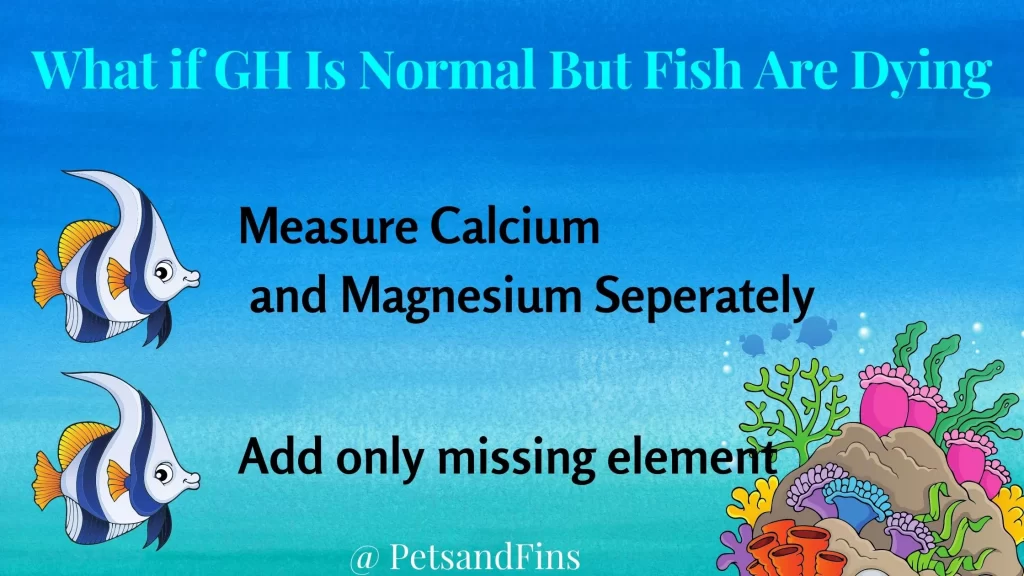
When Should You Measure GH while Increasing or decreasing GH?
When you are trying to increase GH levels you must test the water before the increase and thereafter check after 20 minutes. This will help you understand the change and if you have actually achieved what you needed.
Thereafter, it will depend on whether you need further modification or not. If you need further changes, you can do it in a small way and keep testing until you achieve what is required. This way you will not be overdoing it. It is essential that you are careful while making changes too fast.
Slower changes will help the fish adapt to such change.
When you are trying to reduce GH levels using RO/DI filtered water simply add this slowly over time allowing the system enough chance to adjust between each addition of 50% added then wait 20 minutes before measuring new readings.
Doing so reduces any risk of increasing fluctuations. However, if there is a need for immediate adjustment due to say issues with livestock then you could use dechlorinator or some aquarium peat moss to reduce it quickly.
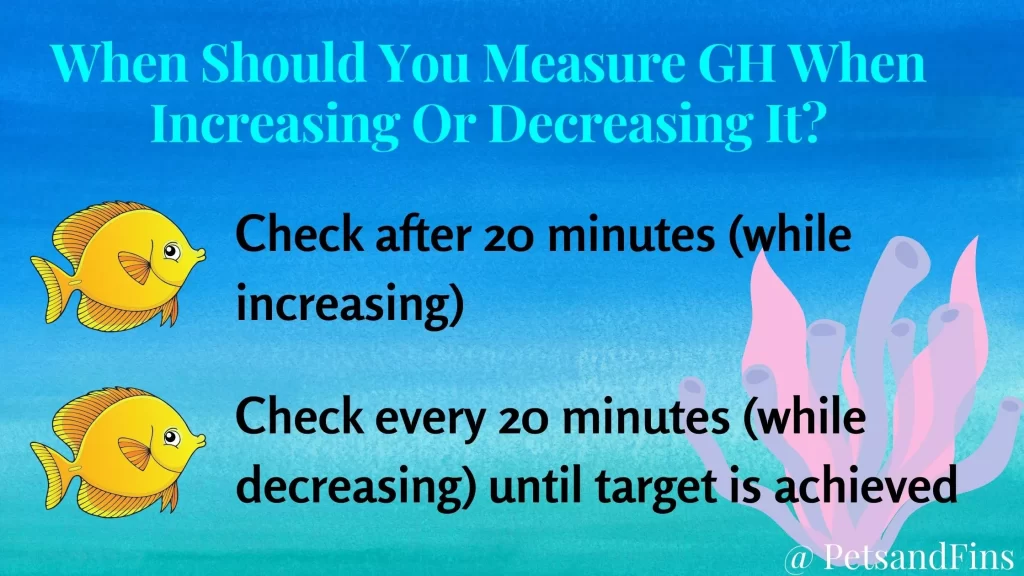
Wrapping Up:
Aquarium water GH is as important as any other parameter. It measures the calcium and magnesium levels in the water. GH ranges from a scale of 1 – 14. GH is not the same as pH. GH can vary for several reasons including what decorations you are using.
High GH can affect the KH and fish will find it difficult to breathe. Low GH will affect the formation of the slime coating on the fish and affect the osmoregulation.GH testing kits are available which help testing kits. 4-8°dGH is optimal for a live plant tank.
Additives are available to increase GH and RO/DI water can reduce GH. Sometimes testing magnesium and calcium levels separately is necessary. Having live plants will be beneficial and helps maintaining the stability of the tank.
Related Questions
How Do Plants Affect GH?
Having live plants in fish tanks can provide both you and the ‘finny fin fins’ with great benefits too! They not only look great through adding color & variety into our aquascapes, but they also help increase oxygenation of water by essentially.
This converts them into plant matter which helps with nitrification etc. When it comes to keeping live plants at their optimum health there are few things that we have to keep in mind.
First, any pH fluctuations must be kept under control as most species require stable conditions throughout their life cycle. If your live plants require soft water conditions then you may want to keep the GH according to those requirements.

